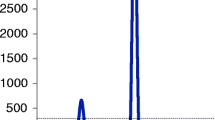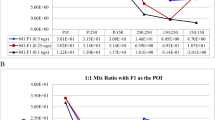Abstract
When more than one individual contributes biological material to a forensic stain, the resulting DNA type is termed a DNA mixture. DNA mixtures occur frequently in forensic genetic casework, and in recent years, much research has been devoted to this subject. This paper presents a derivation of the exact distribution of the number of alleles for any number of profiles and investigated loci. The per locus number of observed alleles is of interest as it indicates the plausible range on the number of contributors. Hence, by specifying a prior distribution on the number of contributors, the locus distribution may be used to assess the number of contributors. Furthermore, the total number of alleles across all loci is used by some forensic geneticists to estimate the probability that an allele has failed to be detected (allelic drop-out).







Similar content being viewed by others
References
Balding DJ, Nichols RA (1994) DNA profile match probability calculation: how to allow for population stratification, relatedness, database selection and single bands. Forensic Sci Int 64:125–140
Biedermann A, Bozza S, Konis K, Taroni F (2012) Inference about the number of contributors to a DNA mixture: comparative analyses of a Bayesian network approach and the maximum allele count method. Forensic Sci Int Genet 6(6):689–696
Buckleton JS, Curran JM, Gill P (2007) Towards understanding the effect of uncertainty in the number of contributors to DNA stains. Forensic Sci Int Genet 1(1):20–28
Gill P, Haned H (2013) A new methodological framework to interpret complex DNA profiles using likelihood ratios. Forensic Sci Int Genet 7(2):251–263
Gill P, Kirkham A, Curran J (2007) LoComatioN: a software tool for the analysis of low copy number DNA profiles. Forensic Sci Int 166(2–3):128–138
Haned H (2011) Forensim: an open-source initiative for the evaluation of statistical methods in forensic genetics. Forensic Sci Int Genet 5(4):265–268
Haned H, Slooten K, Gill P (2012) Exploratory data analysis for the interpretation of low template DNA mixtures. Forensic Sci Int Genet 6(6):762–774
Paoletti DR, Doom TE, Krane CM, Raymer ML, Krane DE (2005) Empirical analysis of the STR profiles resulting from conceptual mixtures. J Forensic Sci 50(6):1361–1366
Paoletti DR, Krane DE, Raymer ML, Doom TE (2012) Inferring the number of contributors to mixed DNA profiles. IEEE/ACM Trans Comput Biol Bioinforma 9(1):113–122
Tvedebrink T, Asplund M, Eriksen P, Mogensen H, Morling N (2013) Estimating drop-out probabilities of STR alleles accounting for stutters, detection threshold truncation and degradation. Forensic Int Genet: Int Suppl Ser. doi:10.1016/j.fsigss.2013.10.026
Tvedebrink T, Curran J (2013) DNAtools: statistical functions for analysing forensic DNA databases. R package version 0.1-8. http://www.cran.r-project.org/web/packages/DNAtools. Accessed 5 Dec 2013
Tvedebrink T, Curran JM, Eriksen PS, Mogensen HS, Morling N (2012) Analysis of matches and partial-matches in a Danish STR data set. Forensic Sci Int Genet 6(3):387–392
Tvedebrink T, Eriksen P, Mogensen H, Morling N (2012) Statistical model for degraded DNA samples and adjusted probabilities for allelic drop-out. Forensic Sci Int Genet 6(1):97–101
Weir BS (2007) The rarity of DNA profiles. Ann Appl Stat 1(2):358–370
Acknowledgments
The author would like to thank two anonymous reviewers for the helpful comments which improved the paper. Furthermore, the author is grateful for allele frequencies for the SGM Plus loci and crime case data provided by The Section of Forensic Genetics, Department of Forensic Medicine, Faculty of Health and Medical Sciences, University of Copenhagen, Denmark. This paper has benefited from discussions with Poul Svante Eriksen, Aalborg University and Prof. Niels Morling, The Section of Forensic Genetics, Department of Forensic Medicine, Faculty of Health and Medical Sciences, University of Copenhagen, Denmark.
Author information
Authors and Affiliations
Corresponding author
Rights and permissions
About this article
Cite this article
Tvedebrink, T. On the exact distribution of the numbers of alleles in DNA mixtures. Int J Legal Med 128, 427–437 (2014). https://doi.org/10.1007/s00414-013-0951-3
Received:
Accepted:
Published:
Issue Date:
DOI: https://doi.org/10.1007/s00414-013-0951-3




